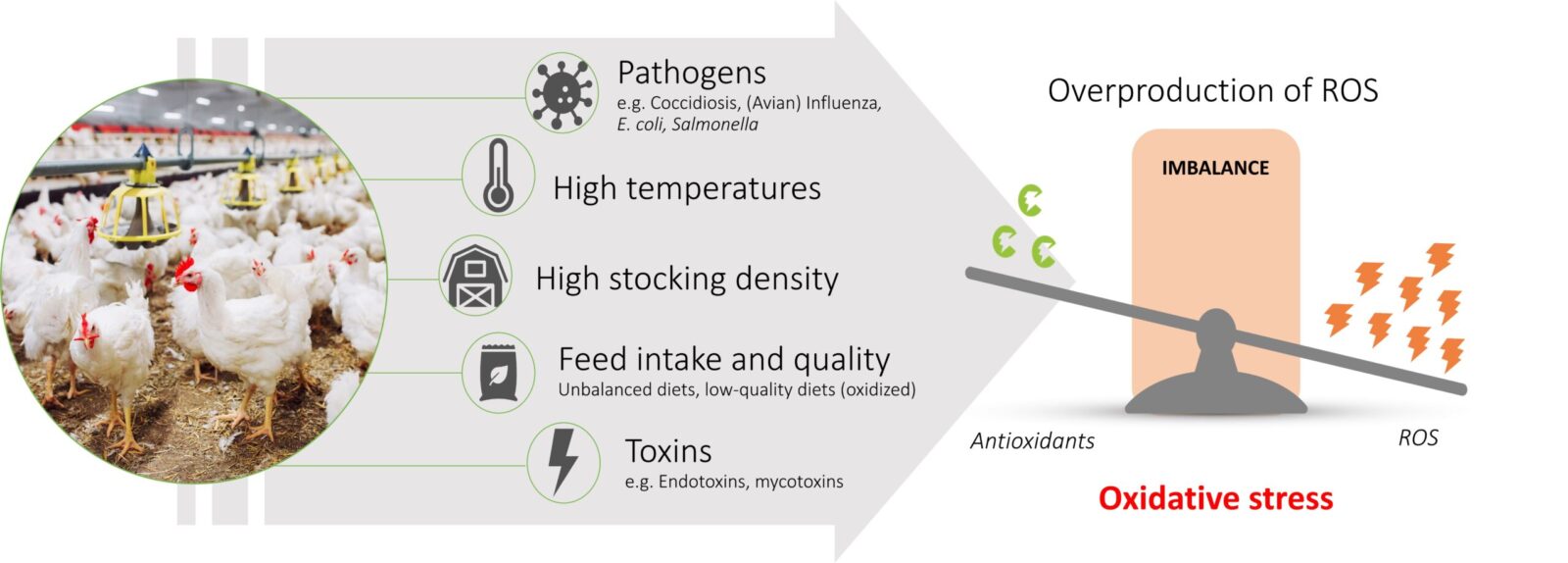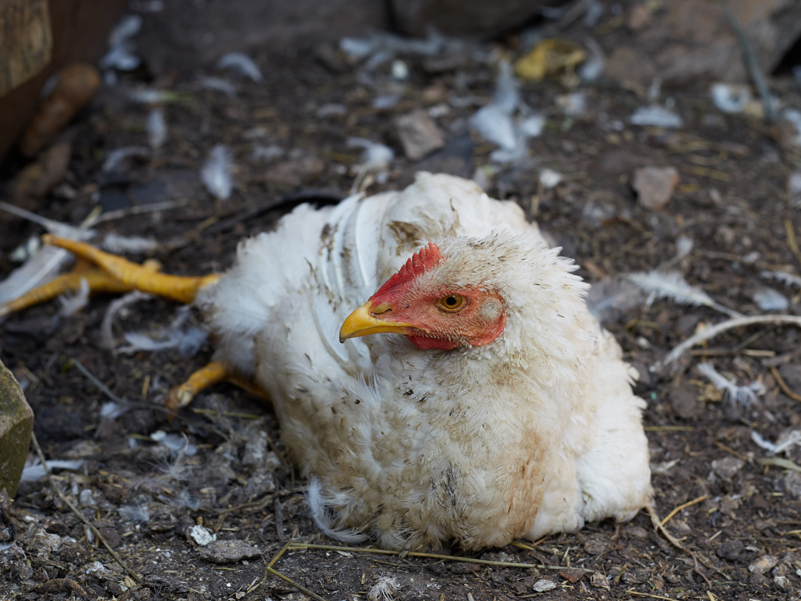Experiencing suboptimal performance in your poultry?
Oxidative stress may be the underlying cause
Improving health and resilience by stimulating their antioxidant defenses
Intensive production systems expose animals to stressors like heat, pathogens, and toxins, leading to oxidative stress – an imbalance between antioxidants and reactive oxygen species (ROS).
This damages cells and tissues, triggers energy-draining inflammation, and hinders growth and production. Minimizing oxidative stress is key to improving animal welfare, performance, product quality, and farm profitability.
Triggers of oxidative stress
Why is oxidative stress more common in intensive production systems?
Today’s intensive production systems put enormous pressure on the natural antioxidant defense system, creating a complex and multifactorial challenge. Various stress factors can induce ROS overproduction, causing imbalance with antioxidants (Figure 1).
Additionally, increased feed intake can elevate metabolic rates, leading to an excessive generation of ROS molecules, which is especially pronounced in unbalanced diets or poor-quality diets, such as feed containing partially oxidized fats or oils.
Moreover, animals in intensive production settings are more exposed to endo- and mycotoxins, which further aggravate oxidative damage.

The consequences of oxidative stress
How oxidative damage undermines production efficiency in poultry farming?
Oxidative stress plays a major role in animal’s overall health and productivity.
It stems from an imbalance between antioxidant defenses and reactive oxygen species (ROS), resulting in damage to cells and tissues. This imbalance has profound implications for poultry, affecting growth, immune function, organ health, and reproductive capacity while leading to economic losses for farmers.
Oxidative imbalance can also lead to various long-term health issues such as neurodegenerative, cardiovascular, hepatic, renal, metabolic and behavioral disorders.
⚠️ PROBLEMS ASSOCIATED WITH OXIDATIVE STRESS
- Reduced growth and production efficiency
- Loss of liver and kidney functionality
- Reduced fertility
- Meat quality issues such as drip loss and discoloration
- Immunosuppression
- Increased susceptibility to pathogens and toxins
- Impaired gut health and digestion
How is oxidative stress impacting your bottom line?

Broilers
Broilers are bred for rapid growth, making them particularly vulnerable to oxidative stress due to their high metabolic rates. Consequences include:
– Growth performance decline:
Oxidative stress reduces feed efficiency and weight gain because energy is diverted from growth to managing cellular damage.
– Meat quality issues:
Increased lipid peroxidation in muscle tissue can lead to poor meat quality, including reduced shelf life, off-flavors, and discoloration. Several known myopathies such as white stripes, spaghetti meat or wooden breast, are linked as well to oxidative stress.
– Immune suppression:
Oxidative stress compromises the immune system, making broilers more susceptible to infections and diseases like coccidiosis.
– Organ damage:
Key organs like the liver and heart are affected, impairing overall metabolic function.
Layer
Layers experience oxidative stress primarily due to prolonged egg production cycles.
Key consequences include:
– Reduced egg quality:
Oxidative stress can decrease eggshell strength and thickness, making eggs more prone to cracking. Yolk quality may also deteriorate due to lipid peroxidation.
– Decline in egg production:
Prolonged oxidative stress reduces the hen’s ability to maintain consistent egg-laying rates.
– Reproductive health issues:
Damage to reproductive tissues can impair oviduct function, affecting egg formation.
– Increased susceptibility to disease:
Similar to broilers, layers with compromised antioxidant defenses are more prone to infections.
Breeder
Breeders are critical for producing high-quality offspring, and oxidative stress can have multi-generational effects:
– Fertility and hatchability issues:
Oxidative stress damages sperm in males and oocytes in females, leading to reduced fertility and lower hatchability rates in eggs.
– Decreased chick quality:
Chicks hatched from breeders under oxidative stress may have weaker immune systems and poor growth potential.
– Health declines in breeders:
Prolonged oxidative stress can lead to organ dysfunction, reduced productivity, and premature culling.
– Feed utilization and weight maintenance:
Breeders may experience difficulty maintaining optimal body weight due to metabolic inefficiencies caused by oxidative stress.
Preventing oxidative damage is crucial for:
- Ensuring animal welfare and reducing health risks
- Maximizing production efficiency by minimizing growth disruptions and maintaining organ functionality
- Supporting sustainable and profitable livestock farming in modern production systems through proactive management of oxidative stress
Tackling oxidative damage with phytogenic solutions
Regular monitoring of flock health and stress levels helps in early identification of oxidative stress. To mitigate oxidative stress in poultry, a combined approach taking into account multiple factors is advised. Safeguard the basic needs, such as:
-
- A balanced feed and nutritional strategy (antioxidants, minerals, and fatty acids),
- A correct environment (temperature, air quality),
- Support the health status (vaccination, probiotics), and stress reduction strategies.
- Additionally, consider using phytochemicals for natural antioxidant support.
Phytogenic products – or plant-based substances – have already demonstrated their potential in the medicinal field.
Recently, several studies have revealed their effectiveness in counteracting oxidative stress in production animals as well, and ascribe it to their antioxidant, anti-inflammatory, and antibacterial properties.
Furthermore, incorporating phytogenic products into animal feed has been shown to enhance digestion by stimulating the production of digestive enzymes and strengthening intestinal tissue morphology, thereby optimizing nutrient absorption and utilization.
Due to their combined properties, phytogenic products serve as excellent candidates for managing oxidative stress.
To conclude
Oxidative stress poses a hidden threat in animal production because it can be triggered by multiple factors while often remaining undetected in animals for extended periods. This can lead to a decline in production efficiency before the problem is even recognized.
Regular monitoring of flock health and stress levels helps in early identification of oxidative stress. Mitigation strategies are multifactorial and phytogenetics are an additive of choice, as their effectiveness in counteracting oxidative stress in production animals is well documented, due to their antioxidant, anti-inflammatory, and antibacterial properties.



